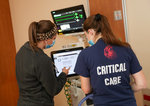 Riviera Beach
Riviera BeachOvercast, 46°
Wind: 0.0 mph, N
 Riviera Beach
Riviera Beach






At the University of Maryland Baltimore Washington Medical Center (UM BWMC), patients in need of critical care come to the hospital during a time of desperate need. And in that time of need, the staff does everything they can to provide high-quality care and comfort to patients.
“Patients are people, and we try to remember that every time we interact with them and their loved ones,” said Dr. Jeffrey Marshall, medical director and chair of critical care and pulmonary medicine at UM BWMC. “It’s not the guy with pneumonia on a ventilator. It’s John, who loves jazz and baseball.”
With that patient-focused mission in mind, UM BWMC provided the Mid-Atlantic region with a gift in December when it unveiled its new critical care unit.
Located in UM BWMC’s south tower, the 17,000-square-foot unit includes 22 large patient rooms, two large resuscitation rooms, a data command center, family rooms and an on-unit pharmacy.
“We wanted it to be warm and welcoming,” said Dr. Jean Jauregui, director of nursing for critical care and intermediate care at UM BWMC. “The new unit has warm colors, bright lights, and every room has a window.”
The new space and features will create the capacity for UM BWMC to better serve the 2,800 critically ill patients per year — or 200 to 300 per month — who rely on the Glen Burnie medical center to treat a variety of conditions, from cardiovascular ailments to smoking-related diseases.
“There are patients having surgery — for example, lung cancer — and they’re going to have curative surgery. And those patients come to the ICU for recovery,” Marshall said. “That’s one population we see and then we have other patients with severe infections and multi-organ failure, cardiac arrest or drug overdoses.”
A 2020 study by the Centers for Disease Control and Prevention found that nearly 30 percent of the U.S. adult population has multiple chronic conditions, or comorbidities. The increase in patients with comorbidities means that Maryland could be facing a shortage of available critical care beds compared to many other states across the nation.
“Right now, the state of Maryland is currently in the bottom 20th percentile for critical care capacity,” Marshall said. “As our population ages, their health needs will increase and there will be a greater need for more critical care beds to help manage people’s care. This unit aims to bring state-of-the-art care to the region, knowing there is a real shortage compared to the majority of the country.”
As a member of University of Maryland Medical System, UM BWMC works with other member hospitals to ensure the right care is provided to each individual at the right time and the right place. That may include the new unit at UM BWMC, supporting care for patients across Anne Arundel County and the larger region. “We often receive patients that are transferred from hospitals on the Eastern Shore that need our critical care services,” Marshall said.
UM BWMC’s new resuscitation area was built to accommodate more than 10 providers in a room at the same time. UM BWMC doctors said the average room could previously fit only five providers. As patients are transported from the emergency department, operating room or from other area hospitals to the critical care unit, the team will stabilize each patient in the resuscitation rooms before continuing to manage their illnesses.
Another vital component of the new critical care unit is the command center and state-of-the-art technology. Each patient room is equipped with an advanced bedside monitor that continuously tracks and transmits patient data to the unit's command center. This centralized wall of computer monitors keeps track of each patient's information 24/7, so that every provider on the unit knows how each patient is doing at any given moment. Changes in a patient's vitals are shown in real-time and trigger the care team to take action, as necessary.
“This advanced technology is giving our care team instant information that can be used to quickly make life-saving decisions," Jauregui said. “Instead of relying on old, point-in-time data, we are getting a real-time feed that alerts us when we need to act. This increases our team's efficiency and helps us provide timely, high-quality and safe care.”
Dr. Jason Heavner, vice president and associate chief medical officer at UM BWMC, wanted the unit to be designed in a way that would meet both the current and future needs of patients.
“New technology and new equipment come out all the time,” Heavner said, “and so we tried to build a space that over the next decade or two will keep up and support new equipment and technology as seamlessly as possible.”
In addition to providing an exceptional and safe space for patients to receive care and for staff to work, UM BWMC also wants to establish the critical care unit as an academic site. Currently, 20 student nurses are getting hands-on experience in the space, and the unit will be used for pilot studies and to research innovative treatments for all 11 hospitals in the University of Maryland Medical System.
“By doing that, UM BWMC shows a commitment to the community and to the mission,” Marshall said. “A clinician can impact one patient [at a time]. A researcher can change patient care for a large population.”
Although the new critical care unit will have many functions, that is the main goal: to provide the best possible care for every patient.
“When a patient comes to critical care, it’s typically the worst day of their life,” Heavner said. “For us to have all the resources in one place – physicians, nurses, clinicians, chaplains – we are able to take care of the entire person, not just medically but in all areas of their health.”
Comments
No comments on this item Please log in to comment by clicking here